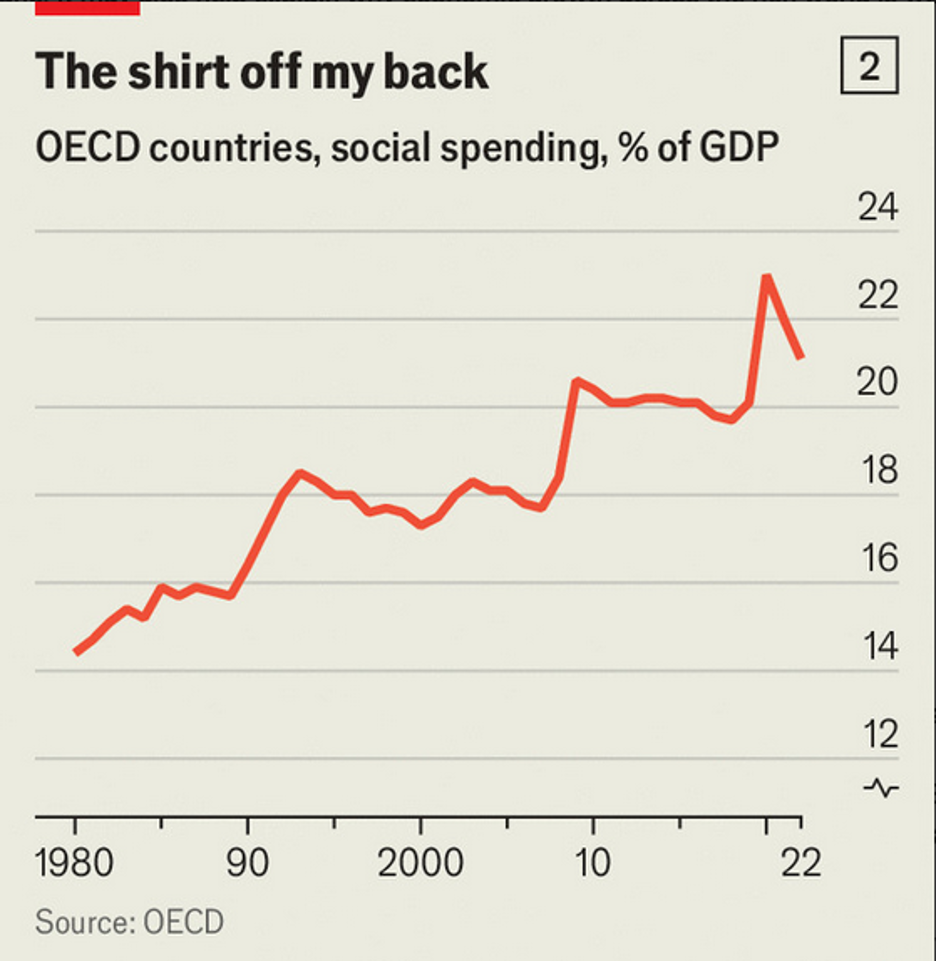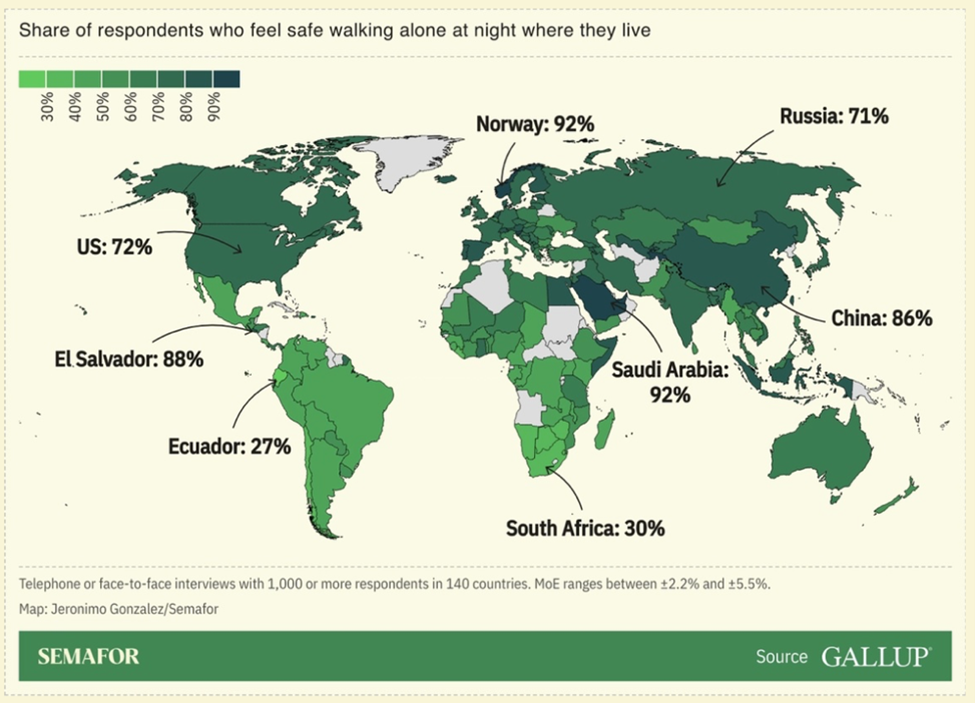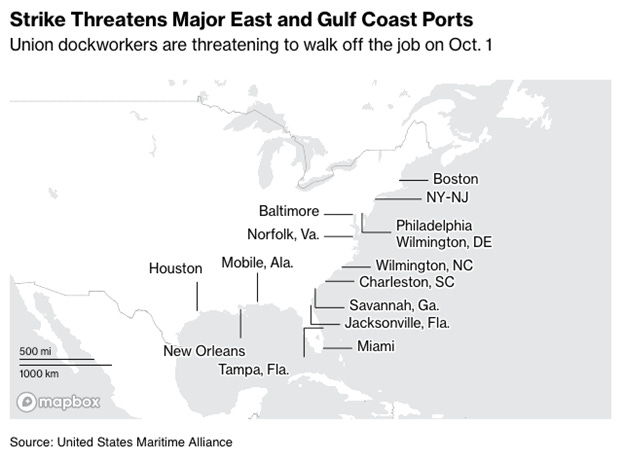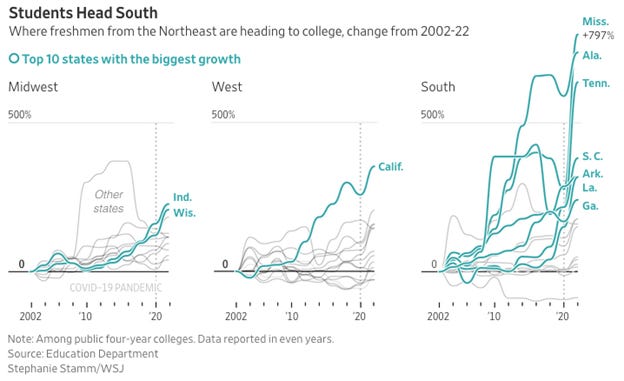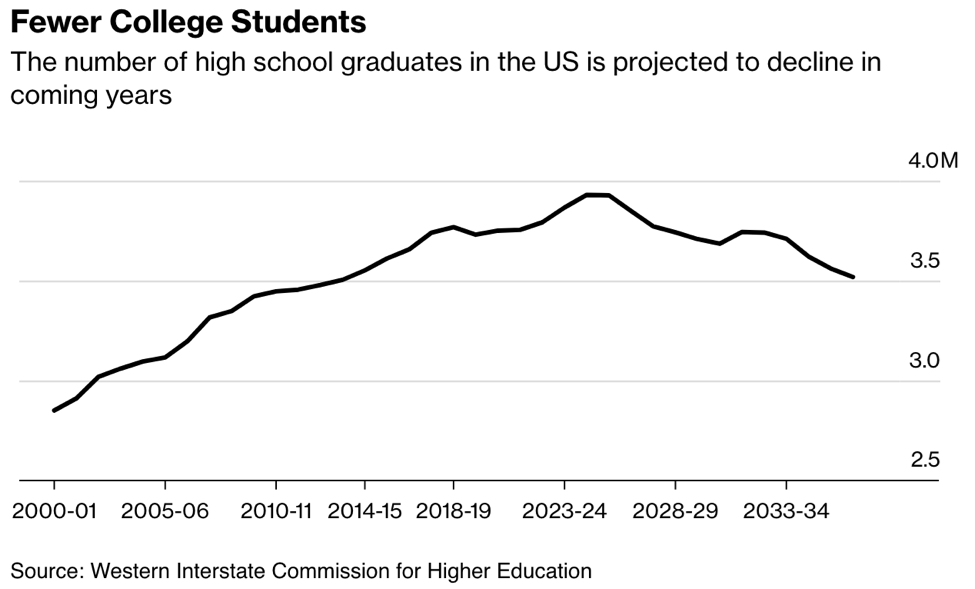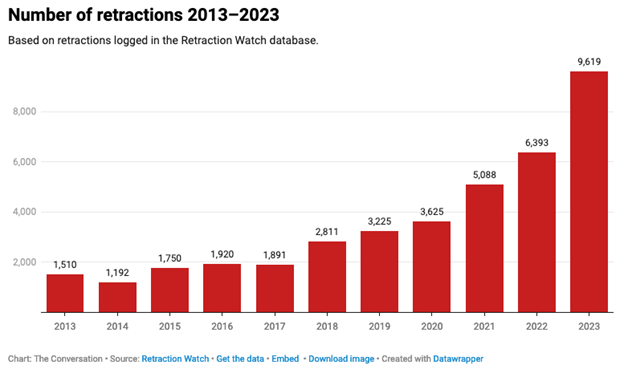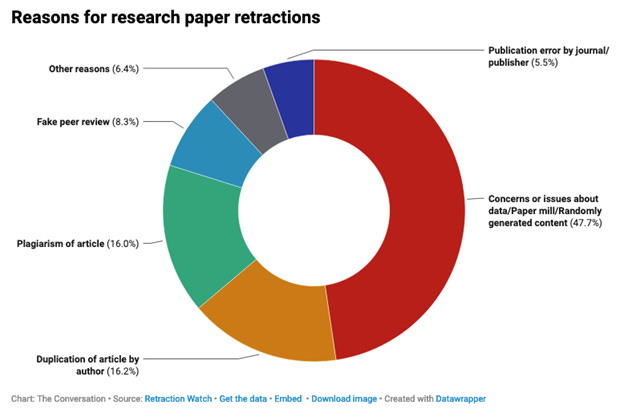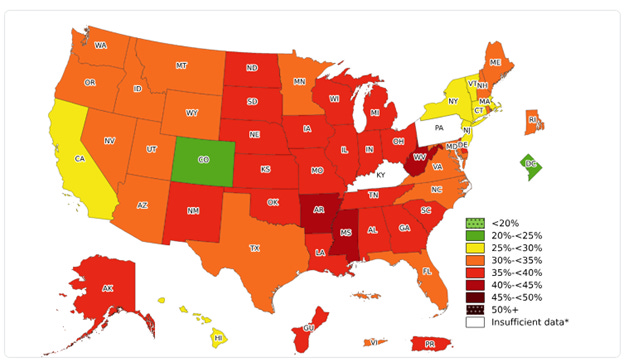10 items that crossed my desk | 29 Sep 24
News from the past week, and a few other things.
👋 Hello Reader,
Of the things that crossed my desk this week, below are 10 items that stood out (plus a few others that didn’t make the top 10 cut).
The Top 10
1. The Corporate Habit Everyone Hates More Than Any Other (Slate)
A corporate “hiking retreat” made headlines last month when a participant was left stranded overnight on a 14,230-foot mountain. The employee and his co-workers were on a daylong “team-building” hike, and he was left behind while the rest of his colleagues made it down the mountain safely. The next day, emergency responders found him trapped in a gully. That a corporate team-building event could end in disaster will come as no surprise to anyone who’s been forced to participate in one. Team-building events are ostensibly designed to boost group cohesion, communication, cooperation, and morale—all worthwhile goals! But in practice, many team-building events are centered on things like blindfolded trust falls, humiliating dance performances, and other activities without any clear connection to those business goals. And although most don’t leave employees literally stranded in the wilderness, they do frequently put them in physically or emotionally uncomfortable situations. All too often, employers plan team-building events without putting real thought into how they’ll produce better results, or they use them as a substitute for more-meaningful work on communication or cooperation issues. Real team building isn’t about one or two events a year. It’s about how a team runs day to day. If a manager, team, or organization doesn’t prioritize communication, corporate, and morale year-round, one-off team-building events aren’t going to change that—and can deeply irritate employees in the process. It’s time for workplaces to kill off artificially designed experiences like the ones above. The most effective team building comes from teams grappling with real-life challenges in the normal course of working together, and doing so collaboratively and respectfully, with opportunities for meaningful input. Doing that takes good management, day after day. Going rock climbing or baby-birding soda into each other’s mouths won’t get us there.
2. Lessons in product leadership and AI strategy from Glean, Google, Amazon, and Slack (Lenny’s Newsletter)
NOTE: I am not a software engineer, but you don’t have to be one to appreciate Lenny Rachitsky’s substack. He does a great job of interviewing people on a variety of topics, though mainly about product development or leadership, and then distilling those interviews down and providing takeaways up front. This recent interview with Tamar Yehoshua provided some great career/leadership advice for just about everyone:
The best way to move up is to crush it in the role you’re in. Don’t get too caught up in the next job title or level—focus on making a significant impact where you are now. This means delivering excellent results, mastering your core responsibilities, and solving real problems. If you’re not excelling in your current position, you won’t get noticed for the next opportunity.
Whether you’re building products or managing teams, success hinges on understanding people. Dive into what drives your users or team members. What do they care about? What frustrates them? Learn to read body language and motivations. This insight is crucial for creating products that resonate and for leading teams effectively.
Operational excellence doesn’t guarantee success. Companies with strong product-market fit can thrive despite internal chaos, while well-run companies may struggle if they don’t solve a real customer need.
Choose a company or role that aligns with your strengths and working style. Just because a company is successful doesn’t mean it’s the right fit for you. Ensure that the work environment and culture match your preferences and career goals.
Don’t stress over having a five-year plan. Instead, focus on where talented people you respect are working. Your career will benefit from being in environments with strong talent and leadership, even if the company isn’t perfect.
Lessons from tech leaders:
Jeff Bezos
Uphold core principles: Define a set of core principles for your team or organization and apply them consistently in every decision. This ensures clarity and alignment across your operations.
Prioritize team input: Bezos always listens to his team before sharing his own perspective. Foster a culture where team members’ insights are prioritized and considered before final decisions are made.
Stewart Butterfield
Prototyping is key: Before full-scale development, invest time in creating prototypes to validate concepts and gather feedback.
Cultivate a long-term vision: Develop a strategic plan with clear long-term goals, as demonstrated by Butterfield’s master plan for Slack. Maintain a focus on your vision while remaining adaptable to changes.
Marc Benioff
Harness the power of marketing: Treat your marketing efforts with the same strategic rigor as product development. Be bold, creative, and strategic in how you present and position your brand to maximize its impact.
3. LinkedIn is training AI on you — unless you opt out with this setting (WP)
You might have used LinkedIn to hunt for a new job, or keep in touch with colleagues from the early days of your career. But LinkedIn has been using you, too. Last week, the professional network added a new data privacy setting that caught many by surprise. By default, it granted itself permission to use information shared on the service to train its artificial intelligence. Unless you toggle this new setting to off, LinkedIn considers everything fair game — your posts, articles, even your videos. To opt out, log into your LinkedIn account, tap or click on your headshot, and open the settings. Then, select “Data privacy,” and turn off the option under “Data for generative AI improvement.” Flipping that switch will prevent the company from feeding your data to its AI, with a key caveat: The results aren’t retroactive. LinkedIn says it has already begun training its AI models with user content, and that there’s no way to undo it.
NOTE: You’ll also note that your data may be used for “Social, economic, and workplace research,” unless you toggle that off as well.
4. This Black Hole Has a Cosmic Wingspan (NYT)
Astronomers announced last week that they had discovered a black hole spitting energy across 23 million light-years of intergalactic space. Two jets, shooting in opposite directions, compose the biggest lightning bolt ever seen in the sky — about 140 times as long as our own Milky Way galaxy is wide, and more than 10 times the distance from Earth to Andromeda, the nearest large spiral galaxy. Follow-up observations with optical telescopes traced the eruption to a galaxy 7.5 billion light-years away that existed when the universe was less than half its current age of 14 billion years. At the heart of that galaxy was a black hole spewing energy equivalent to the output of more than a trillion stars.
NOTE: That distance is so insanely huge.
5. In a First Among Christians, Young Men Are More Religious Than Young Women (NYT)
Church membership has been dropping in the United States for years. But within Gen Z, almost 40 percent of women now describe themselves as religiously unaffiliated, compared with 34 percent of men, according to a survey last year of more than 5,000 Americans by the Survey Center on American Life at the American Enterprise Institute. In every other age group, men were more likely to be unaffiliated. That tracks with research that has shown that women have been consistently more religious than men, a finding so reliable that some scholars have characterized it as something like a universal human truth. The men and women of Gen Z are also on divergent trajectories in almost every facet of their lives, including education, sexuality and spirituality.
6. Mexico Is Building a $7.5 Billion Trade Route to Compete With Panama Canal (WSJ)
The Panama Canal isn’t as reliable as it once was and Mexico is racing to build a new corridor connecting the Pacific and Atlantic Oceans that would help fill the gap. WSJ explores whether it will lead to faster or cheaper shipping.
7. Utah Asks the US Supreme Court to Decide Historic Public Lands Case (Utah.gov)
The United States currently owns nearly 70 percent of the land in the State of Utah. The relative percentage of federal lands in Eastern states is trivial by comparison where the federal government owns less than 1 percent of the land in Connecticut, New York, and Rhode Island, and less than 3 percent of the land in Delaware, Maine, Massachusetts, Ohio, and Pennsylvania. About half of the federal land in Utah has been designated as National Parks, National Forests, National Conservation Areas, and the like, or is being used in service of one of the federal government’s enumerated powers—e.g., as a federal military installation, courthouse, office building, or the like. But the rest of the federal land in Utah—about 34% of the State’s territory—is “unappropriated” land that the United States is simply holding, without formally reserving it for any designated purpose.
NOTE: I never knew there was this much federally controlled land (even when considering Bureau of Indian Affairs).
8. Governments are bigger than ever. They are also more useless (Economist)
In recent decades governments have overseen an enormous expansion in spending on entitlements. Because there has not been a commensurate increase in taxes, redistribution is crowding out spending on other functions of government. On average across the OECD, social expenditure in countries with available data rose from 14% of GDP in 1980 to 21% in 2022. [...]conventional statistics understate the scale of the change. Governments have not helped themselves by failing to raise the retirement age: the average person in the rich world currently retires at age 64, no older than in the late 1970s. Governments also seem less willing and able to pull off big projects. It is just about impossible to imagine that the Empire State Building could be built in a year—and yet, in the 1930s, it was. Moreover, throughout the 20th century governments invested both money and intellect in science and R&D, seeking to shift economic growth into a higher gear. Initiatives like DARPA, undertaken in America to devise and spread groundbreaking technologies, hinted at the scale of governments’ ambitions. In the 1950s and 1960s governments, including Germany’s and Japan’s, built millions of units of public housing and millions of miles of road and rail. Now politicians just want to get from one day to the next. Spending on short-term fixes takes precedence over difficult, long-term projects.
9. Commission on the National Defense Strategy (Senate.gov)
The threats the United States faces are the most serious and most challenging the nation has encountered since 1945 and include the potential for near-term major war. The United States last fought a global conflict during World War II, which ended nearly 80 years ago. The nation was last prepared for such a fight during the Cold War, which ended 35 years ago. It is not prepared today. The Commission finds that DoD’s business practices, byzantine research and development (R&D) and procurement systems, reliance on decades-old military hardware, and culture of risk avoidance reflect an era of uncontested military dominance. The Commission finds…
Finds that the U.S. military lacks both the capabilities and the capacity required to be confident it can deter and prevail in combat.
Finds that the U.S. defense industrial base (DIB) is unable to meet the equipment, technology, and munitions needs of the United States and its allies and partners.
Believes that it is critical to develop innovative joint operational concepts to employ new capabilities and technologies. DoD’s Joint Warfighting Concept (JWC), now in its third iteration, was intended to position the Joint Force for modern warfare against peer competitors.
NOTE: This was published this past July.
10. How Republics Unravel: From Rome to. . . America? (FP)
The dynamic between Trump and his haters has changed the chemistry of American politics. In 2016, Trump shocked the country by leading rallies where his adoring fans chanted, “Lock her up,” referring to his opponent, Hillary Clinton. Eight years later, crowds at Kamala Harris rallies belt out a similar chant, calling for Trump’s imprisonment. In this respect Ryan Routh is part of a larger problem tearing our country apart. When the other side is considered completely beyond the pale—a threat to our very system of government—it’s worth breaking the norms of political decorum to stop them getting into power. You hear it from both parties. Trump is an “extinction-level event.” If Kamala wins, our country will become, in Trump’s words, “Venezuela on steroids.”
NOTE: There’s enough in this article to ruffle the feathers of both sides of the political spectrum…as if they’re not ruffled enough.
I highly recommend the book, Love your Enemies by Arthur C. Brooks. In it, he discusses how we work through the ever-expanding polarization of our nation—moving from contempt for one another, to a place of love through action. Sounds a little mushy, I know, but I think he provides some sound advice. Here’s part of the description from the publishing house:
“Brooks’ prescriptions are unconventional. To bring America together, he argues, we shouldn’t try to agree more. There is no need for mushy moderation, because disagreement is the secret to excellence. Civility and tolerance shouldn’t be our goals, because they are hopelessly low standards. And our feelings toward our foes are irrelevant; what matters is how we choose to act.”
…and the rest
World
The Global Safety Report: Measuring Personal Security Worldwide (Gallup)
The company’s annual Global Safety Report asked 146,000 people whether they felt safe walking alone at night, and 70% said yes, up from 64% in 2013 although down from a 2020 peak of 72%. Progress has not been uniform: People in former Soviet states feel much safer than they did 20 years ago, but those in sub-Saharan Africa and Latin America noted a decline. Ecuador in particular, once relatively peaceful, is now the country where people feel least safe. On the flip side, El Salvador, ranked second last in Gallup’s 2016 poll, is tied for eighth following a controversial crackdown on gang violence.
North America
FBI finds violent crime declined in 2023. Here’s what to know about the report (AP)
Violent crime in the U.S. dropped in 2023, according to FBI statistics that show a continued trend downward after a coronavirus pandemic-era crime spike. Overall violent crime declined an estimated 3% in 2023 from the year before, according to the FBI report Monday. Murders and non-negligent manslaughter dropped nearly 12%.
NFL stadiums will soon double as disaster shelters, federal officials say (WP)
As Hurricane Katrina ravaged Louisiana in 2005, more than 20,000 people sought a makeshift shelter in the Superdome, the home stadium of the New Orleans Saints. Nearly two decades later, the Federal Emergency Management Agency and the National Football League are partnering to turn football stadiums across the country into emergency shelters, temporary hospitals and other venues needed during disasters, according to details shared with The Washington Post. The initiative, which comes as Florida braces for a major hurricane, and floodwaters from Hurricane Francine soak Louisiana, aims to better prepare communities for catastrophic events.
Latin America
Argentina Scrapped Its Rent Controls. Now the Market Is Thriving. (WSJ)
For years, Argentina imposed one of the world’s strictest rent-control laws. It was meant to keep homes such as the stately belle epoque apartments of Buenos Aires affordable, but instead, officials here say, rents soared. Now, the country’s new president, Javier Milei, has scrapped the rental law, along with most government price controls, in a fiscal experiment that he is conducting to revive South America’s second-biggest economy. The result: The Argentine capital is undergoing a rental-market boom. Landlords are rushing to put their properties back on the market, with Buenos Aires rental supplies increasing by over 170%. While rents are still up in nominal terms, many renters are getting better deals than ever, with a 40% decline in the real price of rental properties when adjusted for inflation since last October, said Federico González Rouco, an economist at Buenos Aires-based Empiria Consultores.
NOTE: Here’s a good explanation of why rent controls don’t work:
Price Ceilings: Rent Controls (MRU)
Rent controls are a type of price ceiling. We’ll use our diagram to show how rent controls create shortages by reducing the supply of apartments available on the market. Rent controls also result in reduced product quality, since they reduce the returns to landlords from renting apartments. Landlords respond by cutting costs or performing less maintenance, leading to lower quality. There are search costs associated with rent controls, and they also lead to a misallocation of resources since apartments are not allocated to renters who value them the most.
Argentina’s poverty rate spikes in first 6 months of President Milei’s shock therapy (AP)
Argentina’s poverty rate jumped from almost 42% to 53% during the first six months of Javier Milei’ s presidency, the statistics agency reported Thursday, a steep rise reflecting the pain of the country’s most intense austerity program in recent memory. The government’s finding that Argentina’s half-year poverty rate in 2024 had surged to its highest level since 2003, when the country was reeling from a catastrophic foreign debt default and currency devaluation, marks a setback for the far-right economist. So far, foreign investors and the International Monetary Fund — to which Argentina owes $43 billion — have cheered his controversial fiscal shock therapy that has succeeded in pulling down the country’s monthly inflation from 25.5% last December to 4.2% in recent months.
Europe
Putin proposes new rules for using nuclear weapons (BBC)
Vladimir Putin says Russia would consider an attack from a non-nuclear state that was backed by a nuclear-armed one to be a "joint attack", in what could be construed as a threat to use nuclear weapons in the war in Ukraine. In key remarks on Wednesday night, the Russian president said his government was considering changing the rules and preconditions around which Russia would use its nuclear arsenal. Ukraine is a non-nuclear state that receives military support from the US and other nuclear-armed countries. His comments come as Kyiv seeks approval to use long-range Western missiles against military sites in Russia. Responding to Putin's remarks, Zelensky's chief of staff Andriy Yermak said Russia "no longer has anything other than nuclear blackmail to intimidate the world". US Secretary of State Antony Blinken described the comments as "totally irresponsible" in an MSNBC television interview. Russian ally China has also called for calm, with reports President Xi Jinping has warned Putin against using nuclear arms.
Middle East
As Lebanon Reels From Israeli Attacks, the Future Is Murky for a Wounded Hezbollah (NYT)
Swaths of southern Lebanon are smoldering ruins. Highways are clogged with thousands fleeing the possibility of an even bigger war between Israel and Hezbollah. As towns and villages held funerals on Tuesday, Lebanon was just beginning to grapple with the fallout from its deadliest day in decades. A vast wave of Israeli airstrikes on Monday targeting parts of the country where Hezbollah holds sway killed hundreds of people and plunged Lebanon into a deep state of uncertainty over what Israel would do next, how deeply the militia had been damaged and what sort of response its remaining forces could muster. Israel said it had hit more than 1,000 sites, mostly in southern and eastern Lebanon, aimed at the fighters and military infrastructure of Hezbollah, the Lebanese political party and militia it has been fighting along the Israel-Lebanon border for 11 months. At least 558 people were killed in the strikes, including 94 women and 50 children, Lebanon’s health minister told reporters on Tuesday.
Israel killed Hezbollah leader Hassan Nasrallah in Beirut strike, group confirms (CNN)
The leader of the Lebanon-based militant group Hezbollah, Hassan Nasrallah, was killed in an Israeli airstrike on his underground headquarters in Beirut on Friday, Israel and Hezbollah confirmed. Nasrallah, who had led the powerful group for more than 30 years and was a hugely influential figure in the region, died when Israeli fighter jets struck in an area of the capital’s southern suburbs known as Dahiyeh.
Central Asia
Satellite footage suggests Russia ICBM launch test was a disaster (WP)
According to satellite photos, a Russian Sarmat intercontinental ballistic missile probably detonated during a test earlier this month, raising questions about Russia’s military capabilities and putting a dent in the Kremlin’s nuclear saber-rattling. Maxar satellite images from Saturday appear to show a crater roughly 200 feet wide and extensive damage to the surrounding area at the launch silo at the Plesetsk Cosmodrome in the Arkhangelsk region in northern Russia. Imagery recorded earlier this month does not show any visible damage to the site. “By all indications, a flight test of the Sarmat ICBM, scheduled to take place between 19 and 23 September 2024 ended in failure,” wrote Pavel Podvig, an analyst based in Geneva, who runs the Russian Nuclear Forces project, in a blog post analyzing the images. “The character of destruction suggests that the missile exploded in the silo.”
East Asia
China cuts rates, rolls out other moves to help the slowing economy (AP)
China rolled out a raft of measures Tuesday aimed at countering a prolonged downturn in its property market that is weighing on the world’s second largest economy. The chief of China’s central bank said it would cut the amount of reserves banks are required to keep. It also slashed interest rates on its loans to commercial banks, reduced required down payments for some property purchases and promised other moves to revive the slowing economy. Disruptions and job losses during the COVID-19 pandemic, coupled with falling prices for homes, have left many Chinese unwilling or unable to spend, despite government efforts to encourage purchases of homes, electric vehicles and other big-ticket items. People’s Bank of China Gov. Pan Gongsheng told reporters in Beijing that the reserve requirement for banks would be cut by 0.5 percentage points “in the near term,” and that the central bank would follow up with further cuts. That would free up more money for lending.
China test-fires ICBM for first time in decades (BBC)
China has said it successfully launched an intercontinental ballistic missile (ICBM) carrying a dummy warhead into the Pacific Ocean. The ICMB was launched at 08:44 local time (04:44 GMT) on Wednesday and "fell into expected sea areas", Beijing's defence ministry said, adding that the test launch was "routine" and part of its "annual training". The type of missile and its flight path remained unclear, but Chinese state media said Beijing had "informed the countries concerned in advance". Japan later said that it received "no notice" of the test launch. China's nuclear weapon tests usually take place domestically, and it previously test-fired ICBMs west into the Taklamakan Desert in the Xinjiang region. This is believed to be the first time since 1980 that it launched an ICBM into international waters.
What's behind China's launch of an intercontinental ballistic missile (VOA)
China test-fired an intercontinental ballistic missile into the Pacific Ocean on Wednesday in a rare occurrence, adding to tensions in the region where multiple countries have overlapping territorial claims and both Beijing and Washington seek to project their influence. The launch was part of routine training by the People's Liberation Army's Rocket Force, which is in charge of conventional and nuclear missile operations, and was not aimed at any country or target, the Defense Ministry said in a statement. The ICBM, carrying a dummy warhead, landed in a designated area in the sea, the ministry said, without specifying where exactly. China rarely tests ICBMs out in international waters, with some experts tracing the last such deployment back to May 1980, when Beijing launched a DF-5 missile into the South Pacific. Usually, the PLA test-fires ballistic missiles in China's remote Xinjiang region or in the Bohai Sea. China choosing the Pacific Ocean as the location for test-firing its missile comes across as both a display of its increased nuclear capabilities and as a warning to the United States and its allies in the region, experts say.
China’s Politburo Supercharges Stimulus With Housing, Rates Vows (Bloomberg)
China’s top leaders ramped up efforts to revive growth with pledges to support fiscal spending and stabilize the beleaguered property sector, giving new momentum to stimulus measures aimed at arresting a slowdown in the world’s second-largest economy. President Xi Jinping’s huddle of the 24-man Politburo concluded with a promise to strive to achieve the country’s annual economic goals, the official Xinhua News Agency reported Thursday. Officials pledged action to make the real estate market “stop declining,” their strongest vow yet to stabilize the crucial sector after new-home prices fell in August at the fastest pace since 2014. The government will also strictly limit the construction of new-home projects, the Politburo said, as part of efforts to ease residential oversupply — although such building has ground to a near-halt.
China’s Newest Nuclear Submarine Sank, Setting Back Its Military Modernization (WSJ)
China’s newest nuclear-powered attack submarine sank in the spring, a major setback for one of the country’s priority weapons programs, U.S. officials said. The episode, which Chinese authorities scrambled to cover up and hasn’t previously been disclosed, occurred at a shipyard near Wuhan in late May or early June. It comes as China has been pushing to expand its navy, including its fleet of nuclear-powered submarines.
South Asia
Marxist Anura Kumara Dissanayake sworn in as Sri Lanka’s president (AP)
Marxist politician Anura Kumara Dissanayake was sworn in as Sri Lanka’s president on Monday after an election that saw voters reject an old guard accused of leading the country into economic crisis. Dissanayake, 55, who ran as head of the Marxist-leaning National People’s Power coalition, defeated President Ranil Wickremesinghe, opposition leader Sajith Premadasa and 35 other candidates in Saturday’s election. The election came as the country seeks to recover from a severe economic crisis that led to shortages of essentials such as foods, medicines, cooking gas and fuel in 2022, triggering massive protests that forced then-President Gotabaya Rajapaksa to flee the country and resign. In a brief speech after the swearing-in, Dissanayake pledged to work with others to take on the country’s challenges.
Space
SpaceX Launches Mission to Bring Back Starliner Astronauts (NYT)
Lifted by a SpaceX Falcon 9 rocket, two astronauts left Earth on Saturday afternoon, headed to the International Space Station. Such launches, taking a new complement of crew to the space station every six months or so, have become routine in the past few years, but this one was different. Inside the Crew Dragon spacecraft atop the rocket, there were just two astronauts aboard — Nick Hague of NASA and Aleksandr Gorbunov of Russia — instead of the usual four. The other two seats were left empty to leave room for two other astronauts already on the space station — a shuffling of NASA’s plans caused by difficulties with a different spacecraft, Boeing’s Starliner, over the summer.
SpaceX plans to send five uncrewed Starships to Mars in two years, Musk says (Yahoo)
In June, a Starship rocket survived a fiery, hypersonic return from space and achieved a breakthrough landing demonstration in the Indian Ocean, completing a full test mission around the globe on the rocket's fourth try. Musk is counting on Starship to fulfill his goal of producing a large, multipurpose next-generation spacecraft capable of sending people and cargo to the moon later this decade, and ultimately flying to Mars.
Government
The Problem With a Crowd of New Online Polls (NYT)
Online opt-in pollsters have fared so poorly in recent cycles that they receive less weight than other surveys in our polling averages. Why are these polls faring poorly? The core challenge was always obvious: how to find a representative sample without the benefit of random sampling, in which everyone has an equal chance of being selected for a poll. Over the last decade, this has gotten harder and harder. Even the best firms have struggled to keep up; for the rest, it’s hard to tell how much they’re even trying. What has gotten more difficult? Just about everything. First, there’s the growing compartmentalization of the internet. Then there’s what Pew Research calls “bogus respondents.” Many online panel providers offer financial incentives to encourage people to take surveys. Unfortunately, that’s also an incentive for people — including people outside the United States — to try to collect gift cards and cash rewards by taking many surveys or even by programming A.I. bots to take polls. Online polls don’t have the benefit of random sampling, the foundation of modern survey research. There is no comprehensive list of email addresses, as there is for phone numbers or home addresses. Instead, people’s chances of seeing an online advertisement to take a poll — let alone deciding to participate — depend on their online habits.
VP debate hosted by CBS News set for Oct. 1 between Vance and Walz (CBS)
The vice presidential debate hosted by CBS News is set for Oct. 1 in New York City, with Democratic Gov. Tim Walz of Minnesota and GOP Sen. JD Vance of Ohio both agreeing to participate. The debate will be moderated by "CBS Evening News" anchor and managing editor Norah O'Donnell and "Face the Nation" moderator and CBS News chief foreign affairs correspondent Margaret Brennan.
Business
Port Employers Ask NLRB to Force Dockworkers to Bargaining Table (Bloomberg)
With less than a week until a dockworker strike could shutter every major container port on the US Atlantic and Gulf coasts, port employers and the union disagree on a range of issues — including whether they’re even negotiating. The United States Maritime Alliance accused the International Longshoremen’s Association of engaging in unfair labor practices and asked the National Labor Relations Board to require the union to resume bargaining before their contract expires on Sept. 30. The ILA is threating to walk out on Oct. 1 if there’s no deal on a new six-year contract. The USMX, as the group representing ocean carriers and terminal operators is known, alleges the union has repeatedly refused to bargain since canceling negotiations earlier this summer.
Grocery chains are bigger than ever. See who runs the stores near you. (WP)
Over the past three decades, the traditional supermarket industry shrunk as a handful of big-name grocers acquired their smaller local and regional rivals. Now Walmart, Kroger, Aldi (Süd) and Albertsons own a third of all U.S. grocery stores locations, according to a Washington Post analysis of OpenStreetMap location data. But the marquee companies could further concentrate their dominance: A federal judge in Portland, Ore., is deciding whether Kroger and Albertsons can proceed with a merger in what would be the biggest supermarket union in U.S. history. Here are the supermarket chains with the most locations across the country.
You’re paying for the runway show (Alec Leach Substack)
Runway shows have been around forever, but the format has endured despite huge shifts in technology, clothes and the way we consume them. Designers still want to put on shows, and people still want to look at them, even as the industry has shapeshifted its way through macro-trends like sneakers, social media, fast fashion, influencers and streetwear. The combination of cool location, cool music and cool models is just a really good formula for making clothes feel real and exciting. It says that what you’re witnessing is fashion, not mere clothing. And it’s expensive. A show might cost anything from €500k to €15 million, according to Alexandre de Betak, who’s been producing shows in Paris for as long as I’ve been alive. On top of all the hard costs — the location, the set, the lighting — you’ve got to pay models, stylists, hair and make up artists, as well as PRs to make sure that people actually see it. Then there’s the guests — it costs a lot of money to get all those NBA players, K pop stars, rappers and rich kids together in one place. How do brands finance all of this? You, the customer, are paying for it. Of course, the price for any piece you buy has other stuff factored into it — you’re not just paying for ideas and fabric, but also a warehouse, e-commerce platforms and the HR department’s salary. But the thing with luxury fashion specifically is that a huge, expensive runway show isn’t an operating cost — it’s an essential part of the brands’ price strategy.
Cyber
With Stickers on Phone Cameras, Clubs Defend the Party Vibe (NYT)
On a recent Sunday afternoon, the line outside Berghain, the Berlin techno club, stretched for hours. Hundreds of visitors, sweating in black outfits, lined the dusty path to the door, hoping to be allowed into the former power station, which is known worldwide for its tough door policy, starry D.J. lineups and hedonistic parties lasting nearly 36 hours. The club is also notorious because, despite its reputation as one of the world’s pre-eminent techno venues, its parties aren’t documented online. Clubgoers are warned at the door that photos and videos are banned: Any violation will result in expulsion. To ensure compliance, door staff place stickers on the front and back of patrons’ smartphones, covering their cameras. Although this may seem excessive to visitors, such camera policies have become standard practice in Berlin clubs as a crucial tool for maintaining an anything-goes atmosphere, and clubs elsewhere are increasingly following Berlin’s lead. Respected venues, including Fabric in London and Radion in Amsterdam have all brought in similar sticker rules in recent years. Pikes Ibiza, on the Spanish island famous for its nightlife, announced last month that all visitors must now cover their cameras, so that “what happens at Pikes stays at Pikes.”
Education
Sorry, Harvard. Everyone Wants to Go to College in the South Now. (WSJ)
A growing number of high-school seniors in the North are making an unexpected choice for college: They are heading to Clemson, Georgia Tech, South Carolina, Alabama and other universities in the South. Students say they are searching for the fun and school spirit emanating from the South on their social-media feeds. Their parents cite lower tuition and less debt, and warmer weather. College counselors also say many teens are eager to trade the political polarization ripping apart campuses in New England and New York for the sense of community epitomized by the South’s football Saturdays. Promising job prospects after graduation can sweeten the pot. The number of Northerners going to Southern public schools went up 84% over the past two decades, and jumped 30% from 2018 to 2022, a Wall Street Journal analysis of the latest available Education Department data found. Though far more students apply to Ivy League schools than in 2002, some of the hottest Southern public schools—including Clemson and Georgia Institute of Technology—have seen even a bigger spike in interest. At Alabama, applications were up more than 600% in the same period—about three times as much as bids to attend Harvard.
A College Taps Wall Street Playbook to Rival Ivies on Admissions (Bloomberg)
America’s higher education system, long the envy of the world, is reaching a breaking point. Colleges are folding at a fast clip, while a growing number of people are questioning the value of getting expensive degrees from private schools that have consistently jacked up tuition costs. At a time when many college administrators are whistling past the graveyard, one school is charting a way forward — with all the pains that come with adapting to this new reality. And the strategy is pulled straight from the private equity industry. Northeastern University, which for years was known as a Boston commuter school, has a dedicated mergers and acquisitions team that hunts for targets with the mission of getting big in a hurry. It’s done that and then some: The school will soon own more than 10 million square feet of real estate across 14 campuses globally after snapping up flailing competitors, most recently Marymount Manhattan College in New York City.
The ‘publish or perish’ mentality is fuelling research paper retractions – and undermining science (The Conversation)
When scientists make important discoveries, both big and small, they typically publish their findings in scientific journals for others to read. This sharing of knowledge helps to advance science: it can, in turn, lead to more important discoveries. But published research papers can be retracted if there is an issue with their accuracy or integrity. And in recent years, the number of retractions has been rising sharply. For example, in 2023 more than 10,000 research papers were retracted globally. This marked a new record. The huge number of retractions indicates a lot of government research funding is being wasted. More importantly, the publication of so much flawed research also misleads other researchers and undermines scientific integrity. Fuelling this troubling trend is a mentality known in academia as “publish or perish” which has existed for decades. The publication of research papers drives university rankings and career progression, yet the relentless pressure to publish has contributed to an increase in fraudulent data. Unless this changes, the entire research landscape may shift toward a less rigorous standard, hindering vital progress in fields such as medicine, technology and climate science.
Health
Severe obesity is on the rise in the US (AP)
Obesity is high and holding steady in the U.S., but the proportion of those with severe obesity — especially women — has climbed since a decade ago, according to new government research. The U.S. obesity rate is about 40%, according to a 2021-2023 survey of about 6,000 people. Nearly 1 in 10 of those surveyed reported severe obesity, the U.S. Centers for Disease Control and Prevention found. Women were nearly twice as likely as men to report severe obesity. Most telling though, the results that show that the overall obesity rate in the U.S. has not changed significantly in a decade, even as the rate of severe obesity climbed from nearly 8% in the 2013-2014 survey to nearly 10% in the most recent one. Before that, obesity had increased rapidly in the U.S. since the 1990s, federal surveys showed.
Nature
'AquaFence' Goes Viral as It Protects Tampa General Hospital From Hurricane Helene Flooding (Entrepreneur)
Hurricane Helene hit Florida's Big Bend region as a Category 4 hurricane with 140 mph winds. So far, 33 fatalities have been reported. And while there has been widespread flooding, including the heavily populated cities of Tampa and St. Petersburg, Tampa General Hospital, situated right along Tampa Bay, has managed to stay dry. That's due to a 5- to 10-foot high barrier known as an AquaFence, which is going viral on several platforms because of how it seems to have protected the region's only Level 1 trauma center. AquaFence was founded in 1999 and has offices in Norway and New Jersey. According to the company's website, its systems are "protecting more than $30 billion worth of real estate in the United States alone," including everything from hotels to gas stations to a Shake Shack. The product is designed to be installed quickly and (fairly) easily. In 2023, AquaFence USA President Thomas Briedis told local outlet, WTSP Tampa 10, that 100 feet of AquaFence can be installed in 30 minutes. "They come folded together, kind of like a laptop," he said. "You take them out of the crate, put them down and they fold open."
Amazon forest has lost an area the size of Germany and France (France24)
Deforestation, mainly for mining and agricultural purposes, has led to the loss of 12.5 percent of the Amazon's plant cover from 1985 to 2023, according to RAISG, a collective of researchers and NGOs. This amounts to 88 million hectares (880,000 square kilometers, 339,773 square miles) of forest cover lost across Brazil, Bolivia, Peru, Ecuador, Colombia, Venezuela, Guyana, Suriname and French Guiana.
Travel
Southwest Airlines says it will introduce assigned seats and premium perks in 2026 (AP)
Southwest Airlines executives on Thursday unveiled their vision for Southwest 2.0, an airline that for the first time will give passengers assigned seats, charge them extra for more legroom and offer red-eye flights. And bags still will fly free. The airline will also repackage its sale of vacation packages. It will seek partnerships with international airlines, starting with Icelandair next year, that executives say will make Southwest credit cards and frequent-flyer program more attractive. The changes will amount to the biggest ever at Southwest, which is the original low-cost airline but is now well into middle age and suffering from sagging financial results. Southwest executives pitched the new offerings as they came under increasing pressure from an activist investor who wants to replace the airline’s management and force a review of its strategy. Southwest’s annual profit is on pace to decline for a third straight year, and its stock price has fallen by more than half since early 2021. Southwest had previously given the outlines of changes including assigned seating and extra-legroom seats, but it gave more details about them Thursday. Executives detailed how each of Southwest’s four airfare tiers will come with perks that get better as the price rises.
Sports
20 Million Cards: A Sports Memorabilia Gold Mine Uncovered in Virginia (NYT)
Every day, it seems, Mr. Banazek unearths new historic treasures from a collection of sports cards and memorabilia that he purchased in 2021 from a quiet hobbyist who lived in a neighboring town. But this is not just any assemblage. It is quite possibly the largest private collection of sports cards in the world — and probably by a wide margin. Mr. Banazek estimates that it includes 20 million cards, although other visitors have pegged the number even higher. For comparison, Paul Jones, a man in Idaho who claimed to have the largest private baseball card collection, told a local newspaper in 2020 that his holdings amounted to 2.8 million cards. The largest collection of nonsports trading cards consists of 32,809 items, according to Guinness World Records.
Padres clinch postseason spot with game-winning triple play against Dodgers (NYT)
With two on and no outs in the bottom of the ninth, closer Robert Suarez yielded a hard groundball that went directly to Manny Machado. The star third baseman calmly fielded it, stepped on third base, fired a strike to second baseman Jake Cronenworth and watched as Cronenworth fired another strike, to first baseman Donovan Solano. This was how the Padres secured a 4-2 win against the Los Angeles Dodgers, clinched a postseason berth and turned the first game-ending triple play in the majors in three years.
The 2024 Chicago White Sox are the worst team in MLB history, a record in futility that was well-earned (Chicago Tribune)
After listening all week to Chicago White Sox general manager Chris Getz, manager Grady Sizemore and players discussing their feelings about the inevitable modern-era record for losses the team finally broke Friday night in Detroit, one word seemed to be missing. Frustrating? Difficult? Disappointing? Painful? No, we heard those descriptions a few dozen times. The word I never heard uttered was “unacceptable,” as in “this loss was unacceptable.” Time and again we heard about the bad breaks, as if the Sox had a monopoly on bad luck. We get it. They were millimeters short of a win on Aug. 28 when Texas Rangers left fielder Travis Jankowski’s brilliant leaping catch robbed Andrew Vaughn of a walk-off home run. The Sox bullpen has blown 35 saves. If only a handful of those went the other way, the Sox would’ve avoided going down in history as the worst team ever. But no organization should ever field a team as poorly constructed as the 2024 White Sox and then talk about bad breaks or frustrating losses. This Sox team started out bad and got progressively worse as they crawled toward Sunday’s finish line.
NOTE: The White Sox were so bad this year that their social media manager stopped posting scores of games…and then made fun of themselves for it:
For Fun
It’s the Great Pumpkin, Charlie Brown is a Christmas special wearing a Halloween costume (Vox)
It’s the Great Pumpkin, Charlie Brown has aired every year since it debuted in 1966. It had been a year since A Charlie Brown Christmas became a national sensation, and CBS wanted to keep the Peanuts goodwill going with another holiday special that could air every year. Rather than tackling Thanksgiving — which they eventually did in 1973 — they opted to adapt one of Charles Schulz’s strips in which Linus waits all Halloween night for the Great Pumpkin to arrive. The special did as well as CBS had hoped, and remains the most enduring Halloween television special to this day. (ABC bought the rights to the Peanuts specials in 2000.)
NOTE: I re-watched “It’s the Great Pumpkin, Charlie Brown” this weekend, and after doing so, went down the internet wormhole. Much has been written about the Charlie Brown specials over the years—how the mixture of jazz music, sense of melancholy, and errant subplots shouldn’t work…yet, they do. This one includes Snoopy as a WWI flying ace who must sneak back home across enemy lines, Linus becoming the laughingstock of his friends for believing in something, and Charlie brown getting rocks while trick-or-treating, among a couple of other interweaving story lines. It’s all over the place, but yet it works. One thing I didn’t realize is that this particular special is what spawned the entire genre of movies themed around Halloween. Let this be a lesson to entertainment executives—different can be better.
Have a great weekend!
The Curator
Two resources to help you be a more discerning reader:
AllSides - https://www.allsides.com/unbiased-balanced-news
Media Bias Chart - https://www.adfontesmedia.com/
Caveat: Even these resources/charts are biased. Who says that the system they use to describe news sources is accurate? Still, hopefully you find them useful as a basic guide or for comparison.





